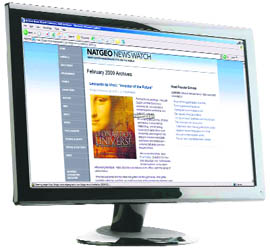Roopinder Singh

When we learn, we generally use a step-by-step progression and this process of thought is known as linear thinking. We progress in a single direction through regular steps or stages, sequential. In our pursuit of knowledge, there are times we want to take detours, learn more about things that we come across and take the road less travelled…we want to indulge in non-linear learning.
Hyper card, an Apple software programme that allowed you to connect cards linking various pieces of information was the rage near the end of the 1980s. It was such an exiting time, since the programme allowed information to be presented in a way that was not linear, and thus added depth.
 The Internet is the best example of the use of hyperlinking, since it allows a reference to a document that the reader can directly follow. The hyperlink points to a whole document or to a specific element within a document. Hypertext is text with hyperlinks.
The Internet is the best example of the use of hyperlinking, since it allows a reference to a document that the reader can directly follow. The hyperlink points to a whole document or to a specific element within a document. Hypertext is text with hyperlinks.
As we progress in the world of knowledge, we learn that it can’t be compartmentalised into neat little subjects, but is actually interconnected in ways that often astound us. Recently, Chandigarhians were treated to a unique event, (courtesy the Chandigarh Lalit Kala Akademi and Arun Nehru, the son of the late Mr B K Nehru), Professor Bulent Atalay’s lecture on ‘Leonardo’s Universe’.
Professor Atalay is the author of Math and the Mona Lisa and Leonardo’s Universe. He is, the Washington Post says, ‘a true Renaissance man – an artist, archaeologist and scientist’. His education includes BS, MS, MA, PhD and postdoctoral studies, completed at Georgetown, Princeton, University of California-Berkeley, and Oxford University.
He is a professor of Physics at the Mary Washington College of the University of Virginia, deeply interested in art. The focus of his particular attention is Leonardo da Vinci, whom he calls a transformational genius. Like many ancient men of knowledge, Leonardo (April 15, 1452 – May 2, 1519) was a person whose expertise spans a significant number of different subject areas. He was an Italian polymath: painter, sculptor, architect, musician, scientist, mathematician, engineer, inventor, anatomist, geologist, cartographer, botanist and writer.
Leonardo’s unbound curiosity matched his powers of invention. Although only a few of his paintings survive, he is considered to be one of the greatest painters the world has seen and is regarded as the most talented person ever. His notes have design of a helicopter, submarine, and a telescope – hundreds of years before anyone else conceived them.
Prof Atalay’s lecture was a fine example of a non-linear experience in which anecdotes, algorithms and art were played out in various measures. He had the standing-room only audience at the Government Art Museum eating out of his hands, even when they didn’t fully understand him… like when he spoke about Fibonacci numbers, where every number in the sequence (after the second) is the sum of the previous two numbers: 1, 1, 2, 3, 5, 8, 13, 21, …. Eventually, the Fibonacci numbers lead to the Golden Ratio: ? = 1.618 033, which has been used by architects and artists to produce objects of great beauty.
For many in the audience, the Fibonacci numbers needed some explaining. An art student sitting next to me Googled it on her mobile phone, and soon we had the answer, we, because she let me have a look at it too. It was great, because the experience became richer.
Time flew by and the lecture lasted longer than we expected. Prof BN Goswamy gave an Indian perspective in his lucid comments and I came back with a copy of Professor Atalay’s book. As he autographed it, I told him: “Your lecture will stay in our minds for a long time, and this book will refresh it.”
The book, brilliantly produced by National Geographic, became my companion that night and the next day, but after I read it, I wanted more, and guess what, I Googled and another world of information opened in front of it.
Since this was browsing in the real sense of the term, I went of excursions, hopped from one site to another, from one facet to another fact about the genius that was Leonardo Da Vinci. As often happens, Wikipedia became an important starting point, of a journey that lead through the Web Museum, Paris, Professor Atalay’s website, which is a fine multi-media experience with sound and a blog in the National Geographic website . For those who missed his lecture, please catch them at YouTube.
I am determined to go on more such journeys. The clicks of the computer’s mouse, and a hyperlinked world of the Internet often come together to give me a sense of exploring the thrilling universe of knowledge, which is both empowering and invigorating. All thanks to hyperlinking.
This article was printed in Lifestyle section of The Tribune on July 21, 2010.
